Lettuce in the Garden: Essential Cultivation Insights
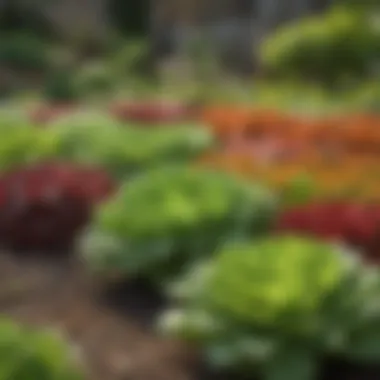
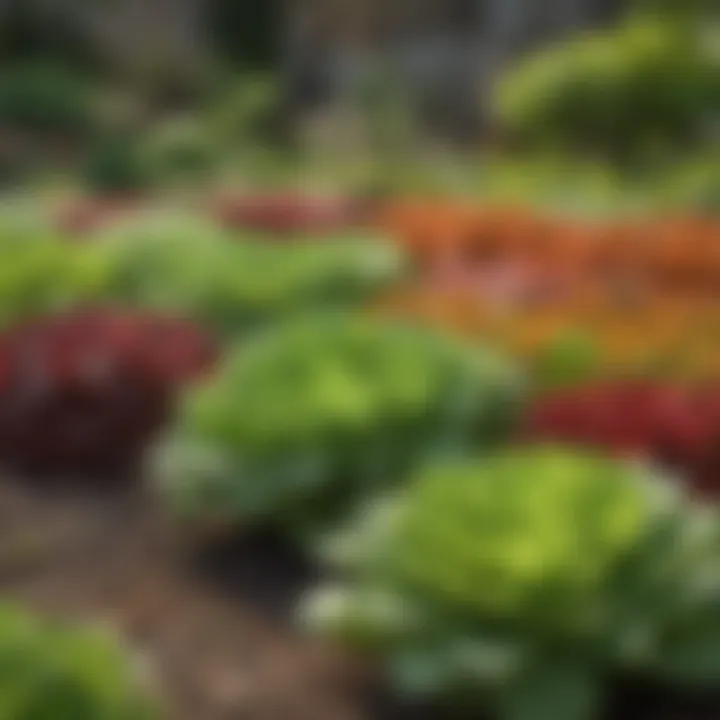
Intro
Lettuce is more than just a leafy green; it serves as a versatile element in gardens across the globe. Its cultural significance and appeal lie not only in its culinary uses but also in the aesthetically pleasing foliage it contributes to outdoor spaces. Every gardener, whether seasoned or a newcomer, can appreciate the clear benefits of cultivating lettuce. As we dive into this guide, various types of lettuce, the ideal conditions for growth, and effective care tips will be laid out to help you make the most of these greens.
Understanding how to successfully integrate lettuce into your garden is essential for achieving a fruitful harvest. Each section of this guide aims to unravel the layers behind lettuce cultivation, ensuring you grasp both the fundamentals and the finer points.
From seeding techniques to pest control mechanisms, the knowledge disseminated here is designed to equip you for a thriving lettuce garden. By the time you finish, you’ll be well versed on how to create a mini lettuce haven right in your backyard.
Preamble to Lettuce Cultivation
Lettuce cultivation holds a special place in gardens across the globe. Whether you're a seasoned gardener or just starting out, understanding how to grow lettuce can open up a plethora of opportunities for enhancing your gardening experience. Lettuce is not just a leafy vegetable; it represents a blend of culinary delight and aesthetic appeal.
The act of growing lettuce is accessible, making it an ideal choice for both novice and expert gardeners alike. There are numerous varieties, each with their own flavors, textures, and uses. Understanding these differences is paramount to maximizing your garden's potential.
Historical Context
From its humble beginnings in the Mediterranean region over 2000 years ago, lettuce has been a staple in many cultures' diets. Ancient Egyptians enjoyed it for its flavor and purported aphrodisiac properties, while Roman emperors considered it a delicacy. This leafy green has undergone countless transformations, both in terms of cultivation techniques and culinary applications.
In the Middle Ages, lettuce was often associated with health and wellness, revered as a salad base or an essential ingredient in hearty meals. Its adaptability to different climates and soils helped it spread across continents. Today, modern farmers utilize advanced cultivation methods, but the essence of nurturing this plant remains unchanged.
Importance in Modern Gardens
In today's gardening world, lettuce is celebrated for many reasons.
- Nutritional value: Lettuce is low in calories yet packed with vitamins and minerals, making it a favored choice among health-conscious individuals. The darker the leaves, the more nutrients they contain.
- Versatility: Whether in salads, sandwiches, or wraps, lettuce plays a pivotal role in elevating flavors and textures in various cuisines.
- Aesthetic Appeal: The different colors and textures of lettuce can enhance garden aesthetics. Varieties such as red romaine or butterhead offer delightful contrasts, contributing to a visually stunning garden layout.
Moreover, lettuce can be grown in limited spaces, making it suitable for urban gardens or container gardening. The swift growth cycle also delivers quick rewards, nurturing the gardener's passion for cultivating and harvesting fresh produce.
Types of Lettuce Varieties
Understanding the different types of lettuce varieties is crucial for any gardener looking to enhance their garden's productivity and visual appeal. There’s a vast world of lettuce out there, each variety bringing its own unique flavors and textures to the table. From the casual salad to elaborate dishes, the variety chosen can make a significant difference. Each type thrives in specific conditions and offers various nutritional benefits, so knowing the right variety to cultivate can greatly influence your gardening success and meal aesthetics.
Leaf Lettuce
Leaf lettuce is perhaps the most familiar variety. It’s loosely structured, featuring tender, leafy greens that often come in stunning shades of green and red. Growing this type is straightforward; it tends to shoot up quite quickly, making it a favorite for beginners and seasoned gardeners alike.
One of the benefits of leaf lettuce is its ability to be harvested multiple times throughout the growing season. By cutting the outer leaves while allowing the inner ones to continue growing, one can enjoy fresh salads for weeks. This variation is also remarkably tolerant to cooler temperatures, making it suitable for early spring or late fall crops.
While growing leaf lettuce, careful attention should be paid to watering practices. It prefers moist, well-drained soil without drying out completely, which can lead to bitterness in taste. Plus, the vibrant colors of Italian or red leaf lettuce can add an exciting visual punch to any garden layout.
Head Lettuce
Head lettuce is characterized by its sturdy, dense heads forming tight rosettes. Varieties like Iceberg are widely recognized for their crisp texture, usually found in eateries. It may not pack a strong flavor punch, but it's much-loved for its crunch.
Cultivating head lettuce requires patience. It can take longer to mature than leaf variants, often up to 80 days, but the wait pays off. This type is generally a bit fussier when it comes to conditions; it needs rich, fertile soil and consistent moisture to reach its full potential. Established gardeners appreciate that once harvested, head lettuce can last for several weeks in proper storage, a great asset in meal prep. The dense head structure also provides excellent shade for the plants surrounding them, promoting a healthier overall garden.
Butterhead Lettuce
Butterhead, with its soft, delicate leaves and buttery texture, is a culinary delight akin to the feel of a gentle caress on the palate. Varieties like Boston or Bibb are well-known for their sweet flavor and crisp texture. They can add a touch of luxury to any salad mixture without being too overwhelming.
This variety requires careful watering, as they thrive in consistently moist conditions, but they don’t appreciate soggy feet. With a short growth cycle ranging from 55 to 75 days, butterhead lettuce is ideal for both novice and skilled gardeners looking to have a quick yield. The key is to ensure that they are kept in partial shade during the hottest part of the day, which prevents wilting and bolting.
Romaine Lettuce
Romaine lettuce is a star performer, especially in caesar salads. Its long, crisp leaves and hearty texture create a satisfying crunch that many people adore. The flavor profile is also quite distinct, offering a more pronounced and slightly nutty flavor compared to other types.
Growing romaine can be a rewarding experience. It prefers cooler temperatures, thriving best in spring or fall. Planted too late in the summer, it risks bolting due to the heat, leading to a less ideal bitter taste. Romaine can also be a bit more resistant to pests, which makes it a great choice for organic gardeners looking to reduce pesticide use. Lastly, romaine lettuce can grow quite tall, so providing enough space between plants is essential to promote good air circulation and reduce disease risks.
"Choosing the right variety of lettuce can transform your garden from ordinary to extraordinary. Not only do these varieties enhance the visual landscape, but they also introduce a diverse range of flavors and textures to your meals."
In summary, knowing these lettuce types can equip you with the ability to select varieties that best meet your gardening aspirations and culinary desires. Whether you are keen on the quick growth of leaf lettuce or the solidity of head varieties, each has its charm and utility in the garden.
Ideal Growing Conditions for Lettuce
Creating a thriving lettuce garden starts with understanding its ideal growing conditions. Recognizing the requirements helps not only in cultivating healthy plants but also in yielding a bountiful harvest. Lettuce, known for its delicate leaves and crisp texture, has specific needs that can significantly affect its growth and quality. Getting the soil, sunlight, and temperature right will set the stage for lettuce that can flourish and bring joy to garden enthusiasts.
Soil Requirements
Lettuce prefers light, well-drained soils enriched with organic matter. A loamy mix, often a blend of clay, sand, and silt, tends to create a balanced environment for root development.
- pH Level: Aim for a soil pH of 6.0 to 7.0. This range ensures optimal nutrient absorption. If the pH strays too far from this zone, it can lead to deficiencies that hinder lettuce growth. Adding lime can help raise pH if needed, while sulfur can lower it.
- Nutrient-Rich: Before planting, enrich the soil with compost or well-rotted manure. This addition not only improves the soil structure but adds necessary nutrients that can boost the plants' health.
- Drainage: Ensure proper drainage by incorporating sand or perlite. Poor drainage can lead to root rot, a downfall for lettuce, which thrives in moist but not waterlogged conditions.
Sunlight Needs
Lettuce thrives in settings that offer adequate sunlight, though it can be a bit finicky with its light exposure. Ideally, it requires around 6 to 8 hours of direct sunlight daily. However, a little shade can work wonders, especially in warmer climates.


- Morning Sun: Gentle morning sun can be ideal as it helps dry any moisture on the leaves, thereby minimizing the chance of fungal diseases.
- Afternoon Shade: In intense summer heat, providing afternoon shade can prevent bolting, a process where the plant flower prematurely and turns bitter.
- Varietal Differences: Be aware that different varieties may have varying preferences. For instance, butterhead may tolerate more shade compared to romaine.
Temperature Preferences
Lettuce is not a fan of extreme temperatures; it prefers cool weather for optimal growth. The ideal temperature range for growing lettuce is around 60°F to 70°F (15°C to 21°C). Here’s what to keep in mind:
- Cold Tolerance: Lettuce can withstand light frosts, making it suitable for planting early in the spring or in the fall. However, prolonged exposure to subzero temperatures can be detrimental.
- Heat Sensitivity: As temperatures climb above 75°F (24°C), lettuce can begin to bolt. This process is a stress response; the plant shifts its energy to flower production, resulting in leaves that are tough and bitter.
- Seasonal Planting: Timing is crucial. Start seeds indoors or sow them directly in the garden as soon as the soil is workable in spring. Consider succession planting to enjoy fresh lettuce through the growing season, adjusting sowing times based on temperature changes.
It's crucial to create the right environment for lettuce cultivation that balances soil health, light exposure, and temperature management to ensure a successful garden. By understanding these key elements, gardeners can cultivate lettuce that not only looks great but also tastes fresh.
Optimizing these conditions will foster healthy lettuce plants and create a robust foundation for a thriving salad garden. With the right approach, your lettuce can be the star of your garden, adding crispness to salads and vibrant colors to your table.
Seed Selection and Planting
Choosing the right seeds and planting them correctly is foundational in lettuce cultivation. The right seed selection ensures a bountiful harvest, while proper planting techniques enhance the growing conditions for the plants. Both these aspects contribute significantly to the overall health and productivity of lettuce crops. It's essential to understand these processes to maximize your gardening efforts.
Choosing Seeds
When it comes to selecting seeds, variety is the name of the game. Lettuce comes in many varieties, each with unique flavors and growing patterns. Opting for seeds that cater to your local climate can make all the difference. For instance, if you're slogging through a hot summer, you might want to lean towards heat-resistant varieties, such as Butterhead or Romaine. Conversely, in cooler climates, Leaf Lettuce varieties typically thrive.
Additionally, consider seeds that align with your culinary preferences. If you're like many who enjoy crisp salads, Romaine might be your go-to. Conversely, if you fancy a softer leaf, Butterhead will delight your taste buds. Remember, seeds that are well-suited to both your environment and your palate can pave the way for a satisfying gardening experience.
Sowing Techniques
Sowing is an art as much as it is a science. You can either start seeds indoors or sow them directly into your garden beds, depending on your local climate and growing season. If you're kicking off your gardening journey early, starting indoors is often advantageous. Use seed trays or biodegradable pots to allow for easy transplantation when the weather warms up.
For direct sowing, ensure that the soil has warmed up sufficiently. Lettuce seeds are small, so it's crucial to spread them thinly to avoid overcrowding. A well-prepared seedbed with finely tilled soil gives each seed a fighting chance. A good practice is to sprinkle the seeds gently on the soil surface and then cover them lightly with soil, about 1/8 to 1/4 inch deep, as they need some darkness to germinate effectively.
Spacing Guidelines
Spacing can make or break your lettuce plants. If planted too closely, your lettuce may compete for nutrients, space, and sunlight, leading to weak plants. Typically, aim for a spacing of about 6 to 12 inches between each plant, depending on the variety. Leaf lettuce can be planted somewhat closer together, while head lettuce varieties need more room to reach their full potential.
Moreover, spacing adequately not only promotes healthy growth but also assists in air circulation, reducing the chances of disease. Think of it as giving your plants some personal space – it helps them thrive. Here are a few tips to remember:
- Plan for your harvest cycle: If you're planning for successive harvesting, consider staggered planting.
- Use a garden planner: This can help visualize your planting scheme and spot any overcrowding.
- Observe your plants: As they grow, take note of how well they are performing and adjust future plantings accordingly.
Quality seedlings, proper sowing techniques, and mindful spacing are essential in the journey of cultivating lettuce. Paying attention to these will lead to a rewarding gardening yield.
Caring for Lettuce Plants
Caring for lettuce plants is crucial for successful cultivation, ensuring that the plants grow strong, healthy, and produce a bountiful harvest. Lettuce is quite a sensitive vegetable, requiring specific attention to its watering, fertilization, and weed management. The right care not only enhances the quality and taste of the lettuce but also minimizes the risk of diseases and pests. Gardeners who dedicate time to nurturing their lettuce can enjoy rewarding results, including vibrant greens that are packed with nutrients.
Watering Practices
Watering is at the core of any successful gardening endeavor. For lettuce, this becomes even more critical as it thrives on consistent moisture. Lettuce has shallow roots which makes it prone to drying out quickly. Ideally, lettuce should be watered deeply but infrequently, aiming for about 1-1.5 inches of water per week. Here are some practices to keep in mind:
- Morning Watering: Opt for watering in the early morning. This helps reduce evaporation and allows water to soak into the soil before the sun gets too hot.
- Soil Check: Always check the soil moisture with your finger. If the top inch feels dry, it’s time to water.
- Avoid Overhead Watering: Instead of watering from above, which can lead to fungal diseases, consider using a drip irrigation system or a soaker hose. This keeps the leaves dry.
Remember, lettuce prefers consistently moist conditions, but overwatering can invite root rot, so find a balance.
Fertilization Techniques
Fertilization sets the stage for nutrient-rich lettuce. Lettuce generally requires less intensive fertilization compared to other veggies, yet ensuring it receives adequate nutrients is vital for robust growth. When selecting a fertilizer:
- Balanced Fertilizer: Use a balanced fertilizer, preferably one with a lower nitrogen ratio to avoid excessive leafy growth while stunting flavor and texture. A fertilizer high in phosphorus and potassium is beneficial.
- Time of Application: Apply fertilizers when planting and a month after emergence. Side-dressing with compost or organic fertilizers can boost nutrient levels during the growing season.
- Liquid Fertilizers: For quick absorption, consider using liquid fertilizers. Dilute as per instructions to avoid burning young plants.
Weed Management
Weeds can become a gardener’s bane, competing with lettuce for nutrients, water, and sunlight. An effective weed management strategy is essential to ensure your lettuce thrives.
- Mulching: Applying a layer of organic mulch around the base of the plants can significantly suppress weed growth while helping retain soil moisture.
- Hand Weeding: While labor-intensive, hand weeding is sometimes the best approach to remove weeds without disturbing delicate lettuce roots.
- Weed Barrier Fabric: Laying down landscaping fabric can also prevent weeds; just ensure it allows water and air penetration.
Incorporating these techniques can not only promote better growth for lettuce but also create a healthier garden ecosystem.
With the right care practices in place, lettuce plants can flourish, bringing both beauty and nourishment to the garden. Emphasizing consistent watering, balanced fertilization, and diligent weed management creates a thriving lettuce garden that yields lush greens for salads and other dishes.
Pest and Disease Management
Pest and disease management is crucial for any gardener looking to cultivate a healthy, thriving lettuce crop. Just as a castle requires a sturdy wall to withstand invaders, lettuce plants need protection against pests and diseases that may threaten their growth. Understanding the potential threats and having a sound strategy in place can make the difference between a bountiful harvest and a garden that falls victim to these foes.
Common Pests
Lettuce faces a barrage of pests, eager to make a meal out of the tender greens. Recognizing these pesky critters is the first step in safeguarding your crop. Here are a few common offenders:
- Aphids: These tiny insects cluster on younger leaves and suck the sap, leading to stunted growth and yellowing.
- Lettuce Webworms: Their silk nests can be found within the leaves, causing significant damage as they munch away.
- Cutworms: These sneaky larvae live in the soil and can cut young seedlings down, leaving you with nothing but disappointment.
- Slugs: Nocturnal munchers, slugs leave behind slimy trails, and will feast on your lettuce, especially during damp weather.
Taking early actions against these pests can save your lettuce. Keep an eye out and act quickly if spotted.
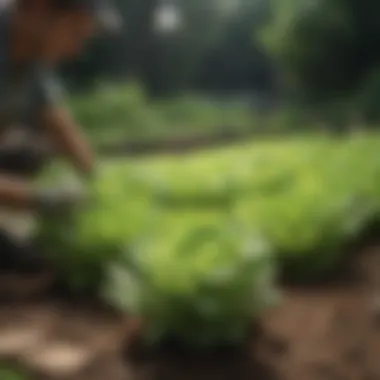
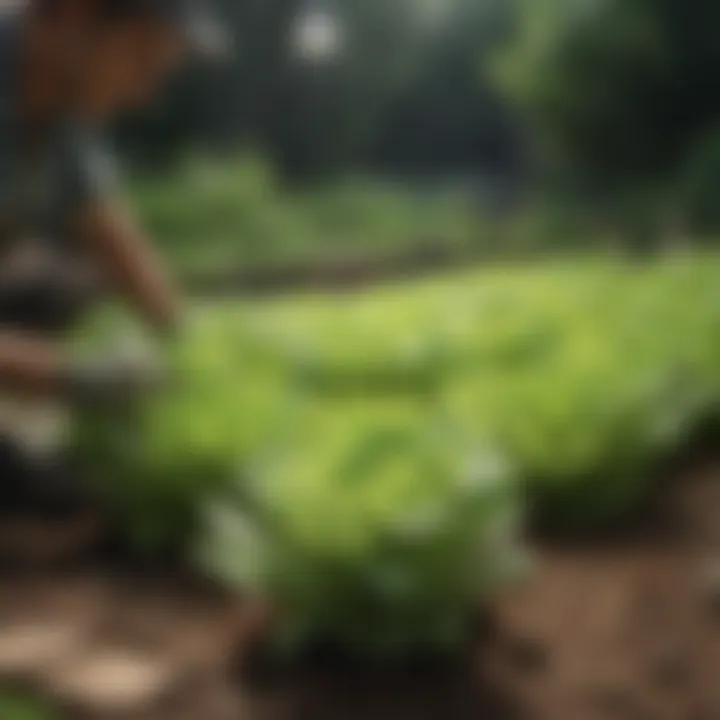
Diseases to Watch For
Just like pests, diseases can wreak havoc on your lettuce garden. Several diseases can strike, each with its own set of symptoms:
- Downy Mildew: A fungal disease that appears as yellow patches on leaves, followed by a grayish downy growth.
- Lettuce Drop: Caused by a soil-borne fungus, this disease makes plants wilt and drop, often suddenly.
- Bacterial Leaf Spot: This manifests as water-soaked spots on leaves, potentially leading to further decline.
Timely identification is vital. If you catch a disease early on, you can implement treatments that halt its progress before it spreads.
Preventative Measures
An ounce of prevention is worth a pound of cure, especially in the world of gardening. Here are several preventative strategies:
- Crop Rotation: Don’t plant lettuce in the same spot every year. Rotating crops can disrupt the life cycles of pests and diseases.
- Healthy Soil: Maintain soil health by incorporating organic matter, which not only nourishes plants but also enhances their natural defenses.
- Proper Spacing: Give your lettuce room to breathe. Proper spacing reduces humidity and improves air circulation, making it harder for diseases to establish.
- Physical Barriers: Use row covers or netting to physically shield young plants from pests.
"An informed gardener stands the best chance against the odds of nature's trials."
By being proactive and observant, the chances of a successful lettuce harvest increase significantly. Integrating these pest and disease management practices into your routine will help ensure that your garden remains healthy and productive.
Harvesting Techniques
Harvesting techniques for lettuce are pivotal in ensuring not only the quality of the produce but also the longevity of the plants in your garden. Timing the harvest correctly can make the difference between crisp, flavorful greens and tough, bitter leaves. With the right approach, you can maximize your yield, minimize waste, and even enhance the aesthetic value of your garden. This section will guide you through the essentials of harvesting, addressing when to pluck your lettuce, the best methods to do so, and how to handle it post-harvest for optimal freshness.
When to Harvest
Identifying the right moment for harvesting lettuce can be somewhat of an art form. Most varieties are ready to be picked anywhere from 30 to 80 days after sowing, which varies significantly depending on the type of lettuce you’re growing. Generally, you’ll want to watch for the following indicators:
- Size and Maturity: Leaf lettuce is best harvested when the leaves are sufficiently large but still tender. Aim for young, vibrant greens that are at least 6 to 8 inches tall.
- Color and Texture: Richly colored leaves often indicate flavorful, mature lettuce, while pale or wilted leaves suggest it might be time to act.
- Weather Considerations: Early morning or late evening is usually the best time for harvesting. During these cooler parts of the day, lettuce is more hydrated, ensuring that the leaves remain crisp.
Ultimately, it’s a matter of knowing your plants and what suits your palate. Be vigilant, and good things will follow.
How to Harvest
Once you’ve determined that it’s time to harvest, the next step is knowing how to do it right. There are a couple of methods to consider, depending on the type of lettuce you are dealing with:
- For Leaf Lettuce: Grasp the base of the leaves and twist gently, pulling them away from the plant without uprooting it. This method allows the plant to continue producing more leaves over time.
- For Head Lettuce: It’s typically best to cut directly at the base using a sharp knife. Aim for an angle to reduce the chance of crushing the remaining leaves.
- For Romaine Type: Pull out the entire head or cut it off at ground level.
A clean, swift motion while harvesting ensures that you don’t damage neighboring plants. Keep your tools sanitized to prevent any risk of disease.
Post-Harvest Handling
After the hard work of harvesting, how you handle your lettuce is critical. You want to keep the freshness intact until it reaches your plate. Here are a few practical tips:
- Immediate Cooling: Place harvested lettuce in a shaded area or a cooler to stop the breakdown of sugars and moisture loss. This is especially important in warm conditions.
- Gentle Cleaning: Wash the leaves carefully in cold water to remove any soil. It’s best to avoid soaking them for too long, which can lead to a mushy texture.
- Proper Storage: Store your cleaned lettuce in a perforated plastic bag or a container with a damp paper towel to maintain moisture while allowing airflow.
"The key to enjoying your home-grown lettuce for days lies in how quickly you cool it off after harvest. Treat it with care."
In summary, understanding the nuances of harvesting techniques can significantly enhance your gardening experience and produce quality. With attention to timing, deft harvesting methods, and careful post-care, you’ll be well on your way to enjoying fresh lettuce straight from your garden.
Integrating Lettuce into Garden Design
In the realm of gardening, the concept of integrating various plants into a cohesive aesthetic and functional scheme can significantly enhance the overall experience. Lettuce, with its vibrant hues and diverse shapes, plays a pivotal role in this endeavor. Its inclusion in garden design isn't just about the practicalities of growing it; it’s about maximizing the efficiency of the garden while also delighting the senses.
Integrating lettuce into the garden can yield benefits far beyond a bountiful harvest. With its short growing cycle, lettuce allows for succession planting and can even be introduced into smaller spaces that might usually feel neglected. Gardening aficionados often find satisfaction in the fresh, crisp leaves of homegrown lettuce, not to mention the unique flavor it brings compared to store-bought varieties.
Companion Planting
Companion planting is the art of strategically placing certain plants next to each other for mutual benefit. When it comes to lettuce, layering it alongside a variety of vegetables can create a thriving ecosystem.
Some examples to consider include:
- Carrots: The deep roots of carrots can help break up the soil, benefiting the shallow-rooted lettuce.
- Radishes: These fast-growing companions can mature before the lettuce needs more room, making them an ideal match.
- Nasturtium: This vibrant plant not only adds visual appeal but also acts as a natural pest deterrent, particularly for aphids.
Furthermore, when strategically placed, lettuce can provide shade to more sensitive crops, thus keeping them cooler in the height of summer. This symbiotic relationship creates a more dynamic garden environment, reducing competition and enhancing growth for all plants involved.
Aesthetic Arrangements
The visual impact of a garden is equally important as its functionality. Lettuce can be arranged in playful and eye-catching designs, making the garden a feast for the eyes as well as the palate. By mixing different varieties—like the vibrant red leaf lettuce with crisp green romaine—you can create visually striking patterns.
Consider these design ideas:
- Row Planting: Straight lines can impart a sense of order, making it easy to navigate and harvest.
- Mixed Beds: Combine lettuce with flowering plants like marigolds to create a burst of color.
- Container Gardens: Use pots to segment different types of lettuce or place them on patios and decks, providing instant beauty and accessibility.
"A well-planned garden isn’t just about the plants; it’s about framing them in a way that lets their true beauty shine."
Ultimately, thoughtful designs can make organic gardening feel less like a chore and more like a canvas for creativity. Additionally, lettuce’s low stature allows for more dynamic vertical arrangements, letting the taller plants stand proudly while the lettuce weaves beneath, blending function with artistry.
Incorporating lettuce into garden design not only optimizes space but transcends the merely functional. It invites a beautiful landscape that enhances the atmosphere, promotes biodiversity, and encourages a rich, satisfying gardening journey.
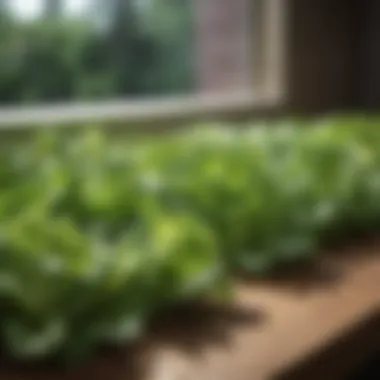
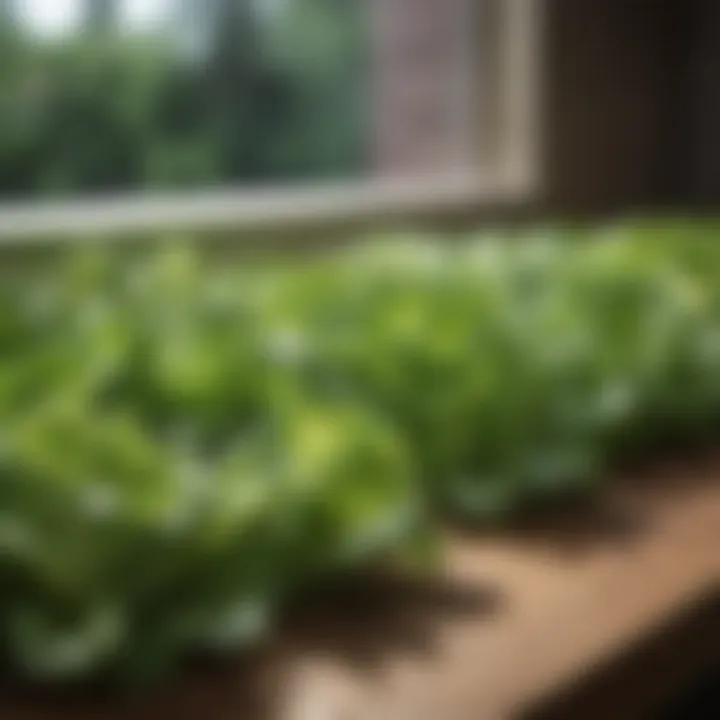
Sustainable Gardening Practices with Lettuce
Growing lettuce doesn’t have to come at the expense of the environment. In fact, sustainable gardening practices are not just a passing trend; they are vital for the longevity of our food systems and the health of our planet. By incorporating sustainable techniques, gardeners can enhance the quality of their crops while minimizing their ecological footprint. This approach can aid in conserving resources, preserving biodiversity, and promoting soil health—all essential aspects when cultivating lettuce.
Organic Cultivation Techniques
When it comes to organic cultivation, the choices you make have a profound impact. By opting for organic methods, gardeners can avoid synthetic fertilizers and pesticides, which not only harm beneficial organisms but can also leach into waterways. Here are several effective organic practices you can employ:
- Crop Rotation: This method involves changing the type of crop grown in a particular area each season. This strategy helps prevent soil depletion and can minimize pest and disease cycles.
- Natural Pest Control: Instead of reaching for chemical sprays, consider introducing beneficial insects like ladybugs or lacewings that can help control pest populations.
- Composting: Creating your own compost from kitchen scraps and yard waste adds nutrients back into the soil. This practice aids in retaining moisture and improving soil structure.
These organic techniques not only support healthy lettuce growth but also contribute to a healthier ecosystem.
Soil Health and Preservation
Good soil is the backbone of any sustainable garden. Healthy soil promotes robust growth and supports a diverse community of organisms that play a crucial role in nutrient cycling. To preserve soil health while growing lettuce, consider the following:
- Mulching: Applying organic mulch, such as straw or shredded leaves, helps retain moisture, suppress weeds, and gradually adds nutrients back into the soil as it decomposes.
- Avoid Soil Compaction: Heavy foot traffic can compact soil and hinder root development. Creating designated paths can help reduce this issue.
- Testing Soil Health: Periodically checking the soil—its pH, nutrient levels, and organic matter content—enables better management of its conditions. Using local sources like reddit.com/r/gardening can offer community insights on how to maintain healthy soil specific to your region.
In summary, sustainable gardening practices tailored to lettuce cultivation underscore the importance of nurturing both the plants and the environment. By embracing organic techniques and prioritizing soil health, gardeners are not only reaping the benefits of delicious and nutritious lettuce but also contributing to a more sustainable future.
Lettuce in Culinary Applications
Lettuce plays a pivotal role in a multitude of culinary spheres, making it more than just a simple salad base. Its versatility spans from casual side dishes to gourmet meals, which are increasingly relevant in contemporary kitchen practices. Whether you’re tossing together a quick sandwich or presenting a refined entrée, lettuce adds both texture and a refreshing bite that complements many ingredients. Understanding how to incorporate this leafy green into your cooking not only enriches flavors but also elevates nutrition in everyday meals.
Nutritional Benefits
Lettuce is often underestimated in its nutritional profile, yet it harbors a wealth of benefits worth exploring. It's primarily composed of water, making it low in calories—perfect for those monitoring their weight. However, the real star role emerges from its array of vitamins and minerals. Here are some key elements:
- Vitamins: Lettuce is rich in Vitamin A, which supports eye health, and Vitamin K, crucial for blood clotting and bone health.
- Minerals: It contains potassium, which is significant for heart function and muscle contraction.
- Antioxidants: Various types of lettuce, particularly darker varieties like Romaine, are packed with antioxidants that fight off free radicals, promoting overall health.
Furthermore, it's an excellent source of dietary fiber, which aids in digestive health. For those trying to meet daily nutritional guidelines, adding lettuce can seamlessly enhance your overall intake of essential nutrients.
Recipes Featuring Lettuce
Incorporating lettuce into your meals can be both fun and delicious. Here are a couple of recipes that showcase its versatility:
- Lettuce Wraps: Utilize large leaves of Iceberg or Butterhead lettuce as a substitute for tortillas. Fill them with your choice of proteins, like grilled chicken or spiced tofu, and add toppings such as shredded carrots, chopped peanuts, or a tangy sauce. It’s not only a health-conscious approach but also adds a delightful crunch.
- Romaine Caesar Salad: A classic for a reason, this dish is fundamentally anchored by the crisp texture of Romaine. Toss in homemade croutons, a rich Caesar dressing, and freshly grated Parmesan cheese for a flavor-packed salad that’s both satisfying and refreshing.
- Lettuce and Avocado Smoothie: For an unconventional choice, blend a handful of leafy greens with avocado, banana, and almond milk. This creamy concoction makes for a nutritious breakfast or a post-workout refreshment.
"Incorporating lettuce into daily meals goes beyond salads; its adaptability opens doors to creativity in the kitchen."
These ideas are just the tip of the iceberg (pun intended) when it comes to the culinary possibilities of lettuce. The next time you're prepping a meal, don't overlook this humble green—experiment with it to see how it can bring texture and taste to your dishes.
Future of Lettuce Cultivation
As we navigate through an ever-changing agricultural landscape, the future of lettuce cultivation holds significant ramifications for gardeners, consumers, and the environment. Understanding where this vital crop is headed not only helps farmers adapt their methods but also guides home gardeners in optimizing their practices in response to global trends.
Trends in Gardening
In recent years, noticeable trends in gardening have started to take root, impacting how lettuce is grown and consumed.
- Urban Gardening: More individuals are taking to balcony and rooftop gardens, discovering innovative methods to cultivate lettuce in confined spaces. This trend not only supports fresh consumption but also reduces reliance on store-bought produce, benefitting sustainability goals.
- Health Consciousness: With a growing awareness of nutrition, more people are turning to lettuce for its health benefits. This shift has propelled a rise in the demand for leafy greens, encouraging gardeners to produce a variety of lettuce types to cater to various tastes and dietary restrictions.
- Permaculture Practices: There's an increasing interest in sustainable techniques that mimic natural ecosystems. A synergistic approach to planting, where lettuce is combined with companion crops, helps to cultivate more nutrient-rich soil, encourages biodiversity, and minimizes the need for synthetic fertilizers.
These trends not only influence how lettuce grows in gardens but also have a broader impact on eating habits and community wellness.
Technological Innovations
Technology is changing the game when it comes to lettuce cultivation. Innovations are not only making the farming process easier but also increasing efficiency and yield.
- Hydroponics and Aquaponics: These soil-less gardening techniques are gaining traction, particularly in urban settings. Hydroponics, which grows plants in a nutrient solution, helps gardeners cultivate lettuce year-round, unhindered by seasonal weather changes. On a related note, aquaponics combines fish farming with plant cultivation, creating a symbiotic environment that provides nutrients for the lettuce while also producing fish.
- Smart Farming: Utilizing IoT devices and sensors, farmers can monitor soil moisture levels, nutrient concentrations, and weather patterns. This data-driven approach allows for more precise irrigation and optimized growth conditions.
- Vertical Farming: As urban spaces grow cramped, vertical farming presents a solution that maximizes space efficiency. With stacks of growing trays, gardeners can produce large amounts of lettuce without needing the expanse of traditional fields.
These innovations empower gardeners to produce lettuce in more sustainable ways, ensuring the crop's viability long into the future.
The future of lettuce cultivation is not just about preserving old practices but embracing the new paradigms that technology and awareness offer.
The transition to more innovative techniques may seem challenging, but it is essential for meeting the demands of a growing population while promoting ecological balance. As societal shifts continue to influence how we garden, lettuce remains a key player in both home gardens and larger agricultural operations.
Closure and Key Takeaways
As we draw our exploration of lettuce cultivation to a close, it’s essential to recognize the myriad benefits and considerations intertwined throughout this guide. The journey through the different varieties of lettuce, their optimal growing conditions, and how to care for them effectively emphasizes why this leafy green deserves a prominent spot in both novice and experienced gardeners’ plots.
Understanding key takeaways helps not just in producing healthy and bountiful lettuce, but also in recognizing its role in sustainable gardening. With an ever-increasing interest in healthy eating and home gardening, lettuce stands out as a symbol of fresh, nutritious, and readily available food right from one’s backyard. It exemplifies how modern gardening can weave together one’s health objectives with environmental considerations, showing that efforts invested in cultivating this versatile plant can yield both culinary delights and a sense of achievement.
Summary of Key Points
- Variety Selection: Different types of lettuce��—like leaf, head, butterhead, and romaine—each bring unique textures and flavors to the table.
- Growing Conditions: Lettuce flourishes in well-drained soil with plenty of sunlight and moderate temperatures, making it a delightful and rewarding crop for most garden settings.
- Care Techniques: Consistent watering, thoughtful fertilization, and vigilant pest management ensure healthy growth and abundant harvests.
- Harvesting and Culinary Use: Knowing when and how to harvest is crucial, as well as being mindful of its nutritional benefits and the many recipes it can enhance.
"A well-tended garden of lettuce not only nourishes the body but also nurtures the soul."
Encouragement for Gardeners
To all the gardeners out there—whether you’re just starting or have years of experience under your belt—don’t shy away from incorporating lettuce into your plots. This leafy green not only adds beauty and variety but also provides a bounty of fresh produce that can significantly elevate your meals. Remember that each seed sown leads to endless possibilities. So get your hands dirty, experiment with different planting techniques, and savor the rewards of your labor.
Engage with fellow gardeners to share tips or simply revel in your successes at local gardening forums. Staying connected with the gardening community can offer further insights and boost your confidence. Remember, gardening is as much about the journey as it is about the harvest. Happy gardening!



